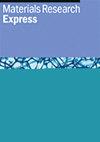掺镱对聚(偏氟乙烯)薄膜电化学和压电特性的影响
IF 2.2
4区 材料科学
Q3 MATERIALS SCIENCE, MULTIDISCIPLINARY
引用次数: 0
摘要
研究了聚偏二氟乙烯(PVDF):二甲基亚砜(DMSO)的最佳摩尔比,该摩尔比可促进 PVDF 薄膜合成过程中 β 相的形成。在 PVDF 薄膜中掺杂六水合硝酸镱 (III) 盐时,采用了溶液浇铸法。一般来说,在 PVDF 薄膜中掺杂镱可改善热阻、促进 β 相的形成、改变单体构象、降低电化学过程的可逆性并增加压电的 d33 系数。掺杂镱引起的β相形成改变了聚合物网络中反式-高切-反式-高切(TGTG')链和全反式(TTTT)链的内部结构。反式高切和全反式结构的共存使两种薄膜中的α相和β相共存。存在自极化的 CH2-CF2 偶极子,其中氟的浓度保持不变,而 CH2 在加入 Yb3+ 后急剧增加。两条伏安循环曲线都显示出准可逆的形状,这与不可逆的氧化和还原反应有关。Yb-PVDF 显示的特定假电容值比 PVDF 薄膜高 30%。最后,镱的加入改善了压电特性。本文章由计算机程序翻译,如有差异,请以英文原文为准。
Ytterbium-doping effect on the electrochemical and piezoelectric properties of poly(vinylidene fluoride) films
The optimal molar ratio of poly(vinylidene fluoride) (PVDF): dimethyl sulfoxide (DMSO) was investigated that promoted the β-phase formation, used during the PVDF film synthesis. The solution cast method was used for doping the PVDF films with ytterbium (III) nitrate salt hexahydrate. In general, Yb-doping in PVDF films improves thermal resistance, promotes β-phase formation, modifies the monomer conformation, reduces reversibility to electrochemical processes, and increases the d33 coefficient of piezoelectricity. The β-phase formation caused by Yb-doping alters the internal structures of the trans-gauche-trans-gauche’ (TGTG’) and all-trans (TTTT) chains inside the polymeric network. The coexistence between the trans-gauche and all-trans structures provides in both films the α-phase and β-phase coexistence. The presence of self-polarized CH2-CF2 dipoles, where the concentration of fluorine remains the same and the CH2 drastically increases after Yb3+ incorporation. The quasi-reversible shape shown in both voltammetry cyclic curves is related to irreversible oxidation and reduction reactions. Yb-PVDF exhibits specific pseudocapacitance values that are 30% higher than those of the PVDF films. Finally, the piezoelectric properties were improved with ytterbium incorporation.
求助全文
通过发布文献求助,成功后即可免费获取论文全文。
去求助
来源期刊

Materials Research Express
MATERIALS SCIENCE, MULTIDISCIPLINARY-
CiteScore
4.50
自引率
4.30%
发文量
640
审稿时长
12 weeks
期刊介绍:
A broad, rapid peer-review journal publishing new experimental and theoretical research on the design, fabrication, properties and applications of all classes of materials.
 求助内容:
求助内容: 应助结果提醒方式:
应助结果提醒方式:


